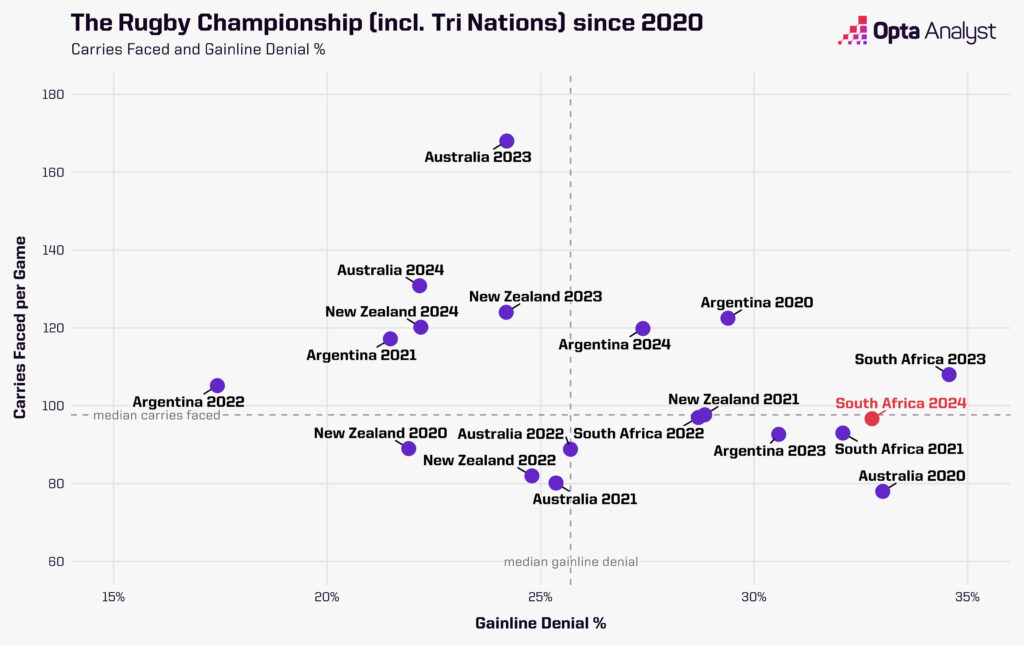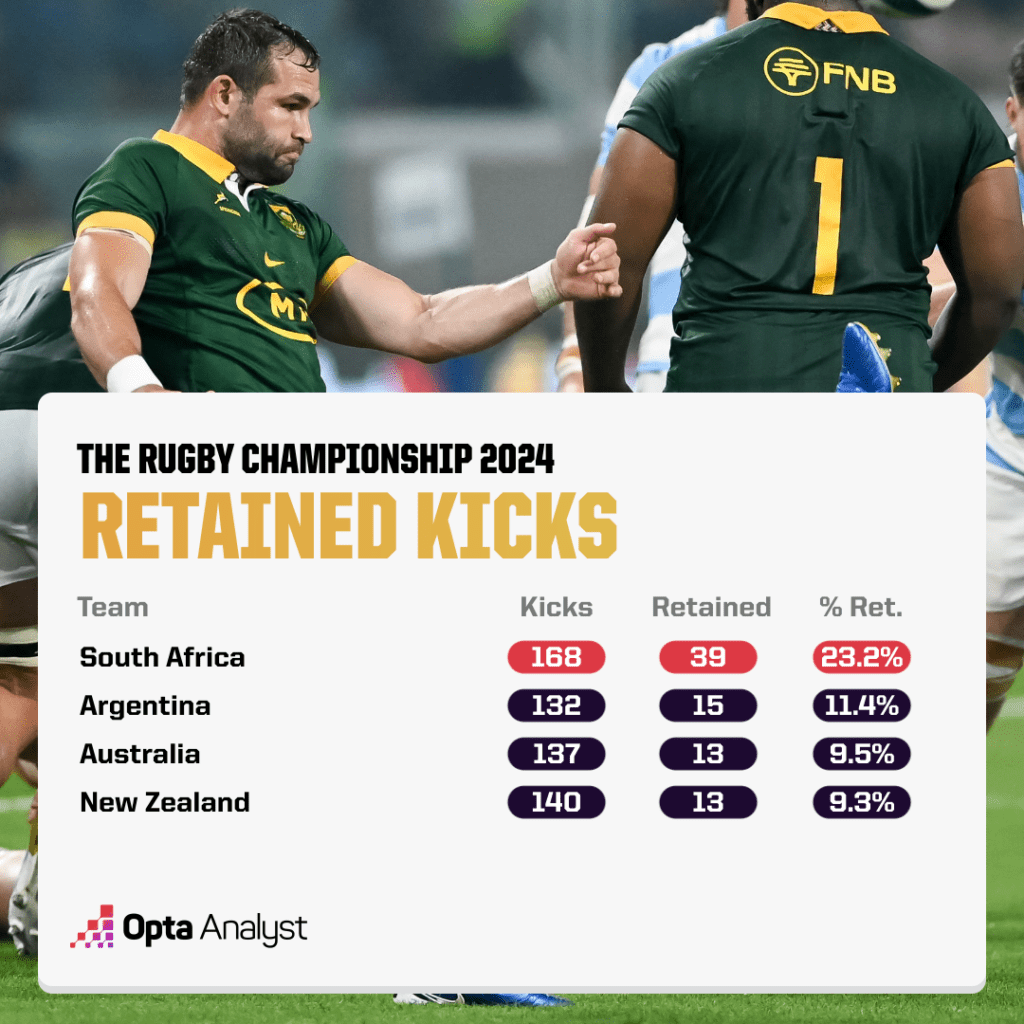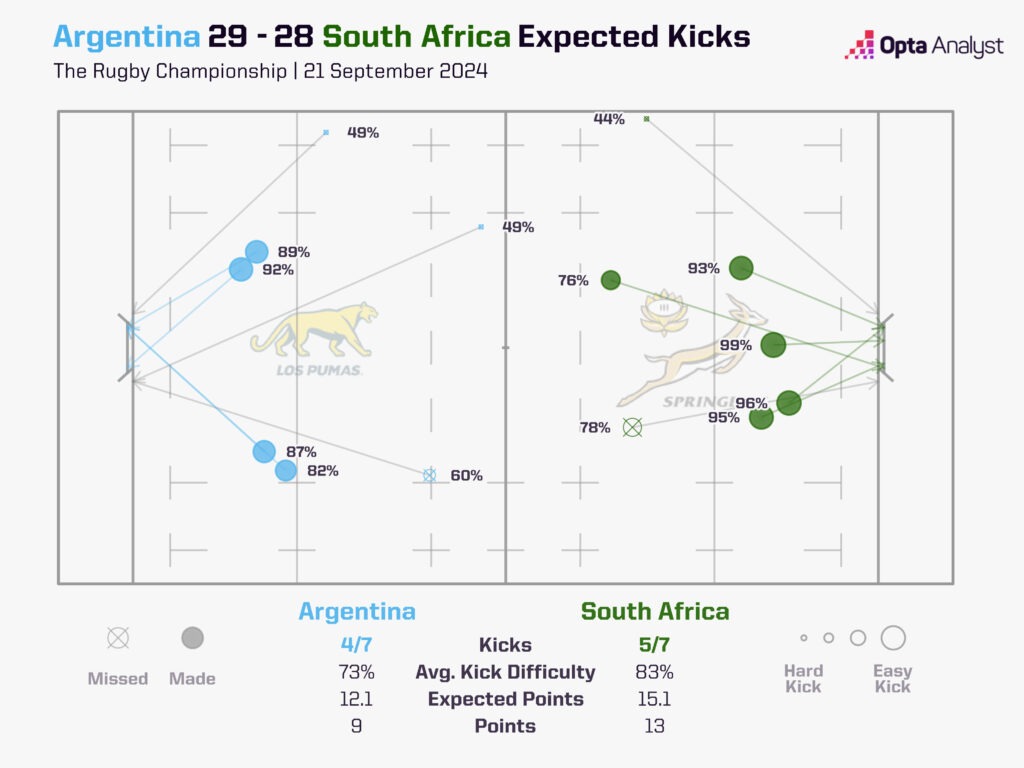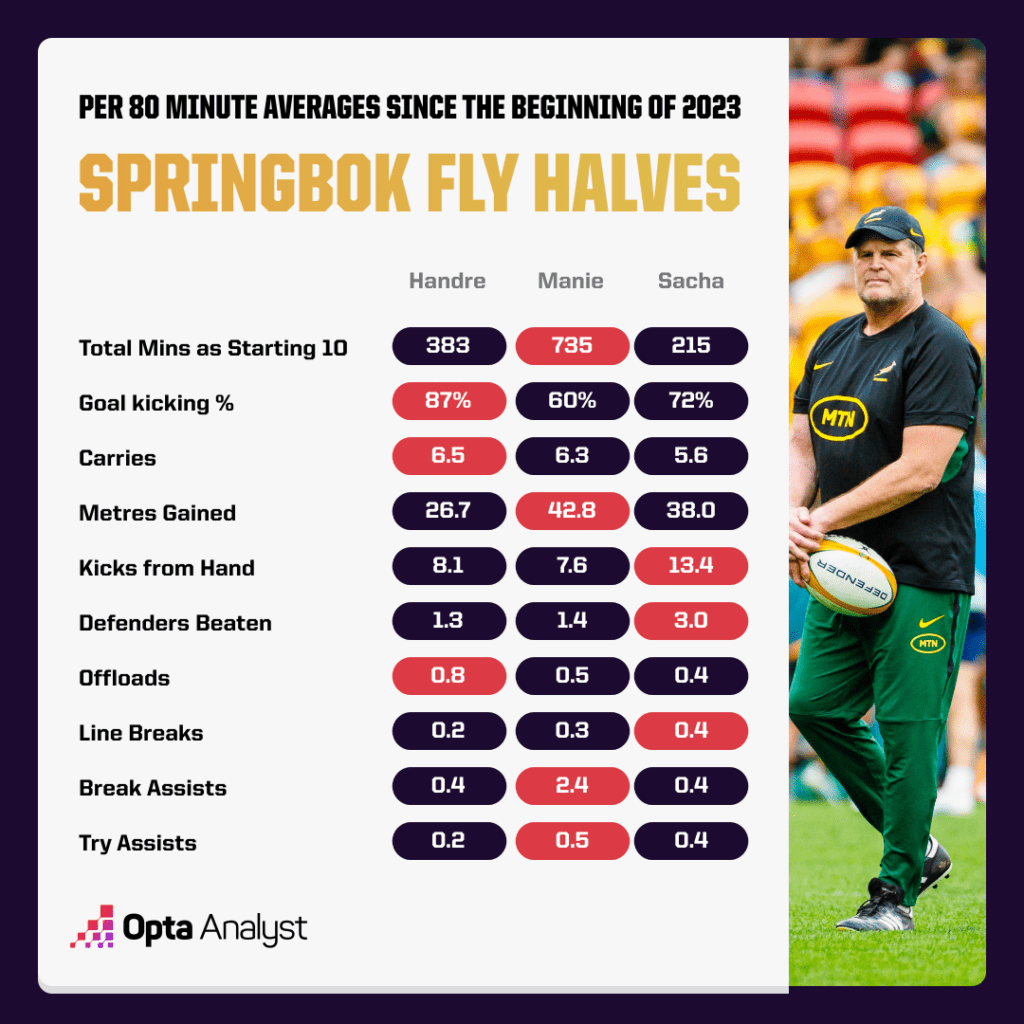The Data Behind South Africa’s Rugby Championship Success
- 5409

After back-to-back World Cup titles and a Lions series victory, South Africa added to their recent trophy collection by claiming the 2024 Rugby Championship title.
This current crop of Springboks are already in the frame to be one of the greatest Test teams of all time. The only criticism levelled at them after lifting a second consecutive Webb Ellis Cup was that they lacked the consistency of the 2011-2015 All Blacks between major tournaments.
However, Rassie Erasmus’ Springboks squad have already started to prove their doubters wrong after a dominant Rugby Championship saw them lift the trophy for the first time since 2019. In fact, it was the first time since the Boks themselves lifted the Tri Nations in 2009 that anyone other than New Zealand had won the championship outside of a Rugby World Cup year, in which the tournament is shortened.
Defence is Key
As the Springboks recorded the lowest tackle success rate in the championship this year (84%), it might, at first, sound strange to suggest their victory was built on a sturdy defence. While a cursory glance at this most basic of defensive data points might suggest that South Africa were shaky when out of possession, it couldn’t be further from the truth when we give that stat more context by looking at the underlying numbers.
Despite their tackle success rate, the Boks’ tally of 127 missed tackles was still a joint low along with New Zealand, while no side conceded fewer line breaks (27, level with New Zealand) or fewer metres (1,735) to their opponents. They also conceded the fewest penalties (58) with just 37 of those penalties coming in defence, at least eight fewer than any other team.
This in turn meant they conceded fewer points (94) than any other side across the championship, with every other side seeing their ‘against’ column in the standings go well into triple figures.
Opta’s expected points (xP) model assesses how many points a team is likely to score within a match, given the areas in which they had possession, along with several other factors. Using this, we can see that Springboks conceded just 94 points from an xP of 178, a difference of 84 points – the biggest of any side.

So how did South Africa have the best defensive record with the lowest tackle success rate?
It all comes down to the way the Springboks defend with ferocious line speed, stopping the ball from getting out wide into areas where there is more space to attack. Often, this forces opposition players to cut back inside, where they may beat one or two defenders but eventually find their way back into heavily congested areas of the pitch.
If we look at defensive gainline numbers, South Africa stopped their opponents from reaching the gainline on 33% of carries in the Rugby Championship this year, the highest rate of any team, showing how quickly they were able to push up in defence and suffocate opposition attacks.

Additionally, looking at the outcomes of South Africa’s missed tackles, 76% saw the opposition player tackled before being able to make a line break or score a try – again the highest rate in the championship. This backs up the notion that the Springboks line speed causes missed tackles, but funnels players into areas where they can’t make meaningful gains.
Control the Game
Rassie Erasmus’ side has never been one that looks flustered. Even when comfortably down on the scoreboard they are a team that has always had confidence in their own game and been able to work their way back into contention.
Their Round 3 win against the All Blacks was a fine example of this, with the Boks winning despite being 10 points behind with just 15 minutes remaining. They are a team that always seems in control, regardless of the circumstances.
Control is a good description of how South Africa approach their game. We have already discussed their ability to deny their opponents the opportunity to get over the gainline, but the Boks’ control of the gainline extends to attack as much as it does defensively, having recorded the best gainline success rate in attack this campaign (63%), thanks in part to registering 799 metres-in-contact, once again a championship high.
They also controlled both possession (55%) and territory (54%) in the Rugby Championship this year, comfortably recording the highest rate of any team in both areas.
South Africa ensured the majority of the play took place in the opposition half in the championship this year, being the only team to enjoy at least 50% of the territory.
Kicking long and kicking often is usually the easiest way to win the territorial battle, but this means giving the ball straight to the opposition, which the Boks obviously didn’t do given their high rate of possession. Instead, they kicked often but they kicked to compete, relying on their chasers to win back the ball, working their way up the pitch but doing so while retaining possession.
South Africa’s 168 kicks had an average distance of 24 metres, at least three metres lower than any other team in the championship. This meant they were able to retain the ball a staggering 39 times from those kicks, just two fewer than Argentina, Australia and New Zealand combined.

Their possession value was boosted by the fact that they were one of the best teams at stringing together prolonged passages of play, putting together 49 possessions that lasted five or more phases, the most of any team.
This was helped by the fact that the Springboks boasted the best ruck success rate (96%), while recording the best ruck speed (3.0s) in the process was an added bonus that allowed them to launch wave after wave of attack.
A Team in Transition?
Perhaps the scary thing for the rest of the rugby world is that South Africa are continuing to evolve their game. There appears to be more ambition to back themselves from deep. They carried the ball out of their own 22 more often than any other side, with 32% of their defensive exits coming via carries – no other side made more than a quarter of their 22 exits in this fashion as the Boks showed their game doesn’t just revolve around set-piece and defensive duties.
They broke the opposition line more often than any other team during the Rugby Championship (50 times), doing so at the best rate of any team too, averaging a line break every 15 carries on average.
Perhaps part of that attacking intent was due to the different playmakers available to them. South Africa have long been able to rely on Handre Pollard, a Test match specialist with ice in the veins and a penchant for saving his best performances for the biggest occasions. Over the last couple of years genuine competition for the 10 shirt has emerged, though, in the form of Manie Libbok and Sacha Feinberg-Mngomezulu, with both offering a different style to Pollard.
In Manie Libbok, South Africa have a fly-half who provides more of a creative spark that can unlock defences, albeit one who has his critics when it comes to the clutch moments off the tee – something that cost South Africa in their solitary defeat in the competition this year.
Meanwhile, Sacha Feinberg-Mngomezulu – who had a breakthrough campaign this year – could be the man to bridge the style gap between the aforementioned number 10s.
Taking into account starts at fly-half since the beginning of 2023, there is no doubting that Libbok is the most creative at opening up opposition defences, having assisted more tries and line breaks than his two rivals for the 10 jersey, as well as averaging more metres gained per 80 minutes.
However, his goal-kicking at Test level has been a weakness, having landed just 60% of his place kicks since the beginning of last year when named in the starting lineup – something that cost the Boks in their defeat to Argentina this year.

Manie Libbok’s last minute kick vs Argentina which would have won the game had an xGK of 78%
While Libbok is the creative spark, Feinberg-Mngomezulu has shown more of a kicking game in his brief time in the Boks XV so far, averaging almost twice as many kicks from hand per 80 minutes as Pollard or Libbok have since the beginning of 2023, with 59% of his touches in the playmaker role ending in kicks.
However, despite kicking more often, the young Stormers fly half has shown a strong running game on the occasions that he does attack the defensive line – averaging three defenders beaten and 0.4 line breaks per 80 minutes, better tallies than Pollard or Libbok have managed recently.

Pollard of course is the metronomic goal-kicking machine who has marshalled South Africa to World Cup glory on two occasions and is still a vital player for the team.
Having three top-class fly-halves is a good problem to have and gives the Springboks a different dimension in how they approach each fixture and with such competition for places – not just at number 10 but all over the pitch – South Africa look set to dominate for a good while yet.



















